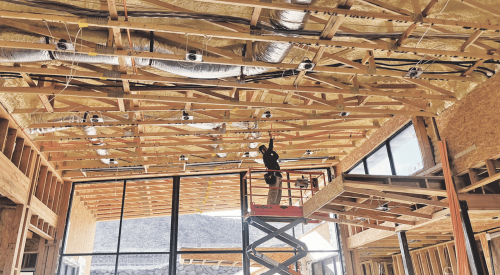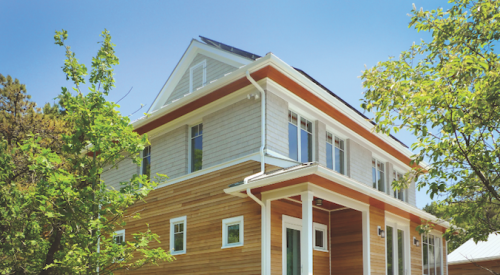|
Ideal Homes built the first zero energy home in the country priced under $200,000. The modest one-story, three-bedroom, two bathroom home produces as much energy as it consumes in a year, achieving net zero energy consumption.
Ideal Homes of Norman, Okla., winner of the 2006 National Housing Quality Gold Award, prides itself on its commitment to building high-performance homes.
 |
 Photovolatics placed on the south-facing roof of Ideal Homes' Zero Energy Home captures energy from the sun to help offset consumption. |
"For years we've done test sites — homes we built to try out the latest in energy-efficient building," said Vernon McKown, co-founder and president of sales for Ideal Homes. "We learned from all of them and incorporated the best practices into every one of the homes we've built since."
Ideal Homes' most recent test home, one of several done in partnership with the U.S. Department of Energy's Building America program, is the first affordable zero energy home (ZEH).
A ZEH is connected to the utility grid, but at off-peak time periods, it generates more power than it uses by combining renewable energy technologies with advanced energy-efficient construction. As a result, a ZEH lowers the power demand on its utility provider. It produces about as much energy as it consumes during a year, so it is considered to achieve "net zero" energy consumption.
 |
Ideal Homes is the first to build a ZEH under $200,000, making this model home affordable for most home buyers. The house was completed in September 2005.
"What Vern did," says George S. James, Building America project leader for Ideal Homes' affordable ZEH, "with my Building Science Consortium, is build a prototype to see what it would take to really do it at a price, at least in Oklahoma, that was not excessive. His houses normally sell for about $125,000, something like that. With the 5.3 kW photo cells and the ground source heat pump and so on, the selling cost is about $200,000."
"Zero energy homes get a black eye in my mind," says McKown, "Every time they do a demonstration site, they run out and they hire some brilliant architect and they go off and they build this one-off amazing house that sticks out of the neighborhood like a prairie chicken, and it costs a million dollars. Everybody looks at that and says, 'That's interesting. With enough money, you can do anything.'
"We wanted to show that you can take any house out of a builder's product line," McKown continues, "and make it a zero energy house and it would look and feel and be just like a regular house, and it doesn't have to cost a million dollars. We could do it under $200,000."
Ideal Homes' ZEH measures about 1,650 sq. ft. and has three bedrooms, two bathrooms and a two-car garage. It's based on one of the builder's stock floor plans.
"The AndersonSargent house in Dallas was a 3,000-square-foot house that sold for a million dollars," says McKown. It made the front page of 50 newspapers worldwide.
"Our little house was so ordinary that it was not interesting," adds McKown. "I just think the ordinary nature of it was what made it so extraordinary."
McKown is good friends with Jim Sargent, a principle for AndersonSargent, and says Sargent actually helped him work through a lot of the details of his affordable ZEH.
"Jim's claim to fame is building really high-performance little houses," says McKown. "He calls them jewel boxes. He's a lot prouder of his little high-performance houses than his big zero energy house, although his zero energy house was a blast for him."
|
Ideal Homes' Zero Energy Home Technology |
 An inverter converts DC current from the solar cells on the roof to usable AC current. |
 A tankless system remote control with digital display. |
The ZEH has been a great traffic draw for Ideal Homes' Valencia neighborhood — its first master-planned community located in Edmond, Okla.
"It's a very green-focused community," says McKown. "It has 40 acres of parks and trails in it. At the design concept, we engineered a process to capture all our drainage water and use it in a series of retention ponds, and then we used those ponds to irrigate the common areas. The irrigation system is solar-powered."
Participating in a demonstration house has advantages of its own.
"We did an American Lung Association Health House back in 1997," says McKown. "We've done I don't know how many Build America houses, but a bunch of them. Every time we build a new demonstration house, we learn a tremendous amount in terms of new technologies that we end up mainstreaming in our everyday product.
"For instance," says McKown, "when we did our American Lung Association Health House, we piloted several different ventilation strategies. And then all of a sudden, we made a fresh-air ventilation strategy part of a standard feature in our houses.
"We knew that if we built this zero energy house," adds McKown, "there might be some low-hanging fruit that could come out of it that you could see Ideal Homes introduce in the next 18 months in our everyday production houses. That's why it was important to us."
ChallengesIdeal Homes normally incorporates energy-efficient construction methods like fresh-air indoor HVAC systems; low-e vinyl windows; and insulation systems in walls, ceilings and around foundations. In addition, for the ZEH, it placed photovoltaics on the south-facing roof to capture energy from the sun and help offset consumption; used ground source heat pumps buried underground to harness the earth's constant temperature to heat in winter and cool in summer; installed tankless hot water systems that heat water instantly when the tap is turned on, conserving energy by not maintaining heated water 24 hours a day; and added energy recovery ventilation to maximize operating efficiency.
The use of these renewable energy technologies can be pricey, but costs remain similar regardless of the price of the home.
"We looked at what would be the most cost-effective way to get it done," says McKown. "We tried to keep it as standard as possible, so that was our first piece of it. The second one was just being very sensitive to the cost of things. For instance, we could have done the ground source heat pump and integrated the hot water tank system, but we could install a tankless hot water system cheaper and get the same net result. Or we could have gotten the solar hot water tank, but again, it was significantly more than the tankless hot water system, so when it came to hot water, we went with the most economical option.
"Another consideration we looked at was ducts in conditioned space," McKown continues. "[That] was going to cost us more than $500, and in terms of heeding the performance metrics and getting to zero [energy] on our model, it had a very minimal impact on the performance. Five-hundred dollars is so trivial, but when you're trying to do affordability, you've just got to make those $100 decisions at every 'Y' in the crossroads or you'll look up and be $50,000 or $60,000 into the system with marginal return."
SuccessThe ZEH model is a test house and is not an available plan for purchase, but it has created so much interest and traffic at Valencia that sales in the community are brisk — they've averaged 20 homes per month since June of 2005. Ideal Homes has had an increase in requests for tankless water heaters, ground source heat pumps and other elements of the ZEH, but not for a replica of the ZEH.
"We've actually put out an information sheet to give to customers on where to get a tankless hot water heater ... where to get photovoltaics, the brands we used. People wanted to buy it in pieces.
"People were more interested in high-performance houses," McKown adds. "We had a couple thousand people through the model, and a large majority of them wanted to get more information about how they could buy a more super energy-efficient house, not necessarily a zero energy house."
The ZEH will be rented out for one year so that its energy performance can be monitored, and then the house will be sold. Projected proceeds from the sale have already been donated to the Central Oklahoma Habitat for Humanity.
|













